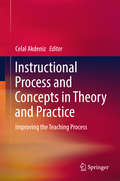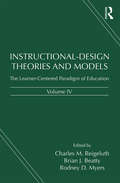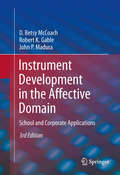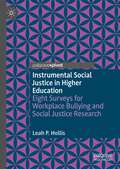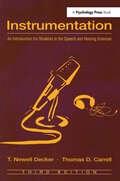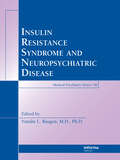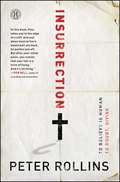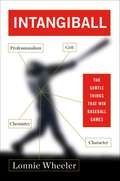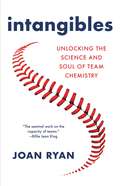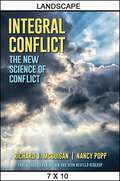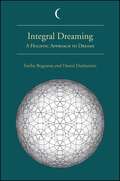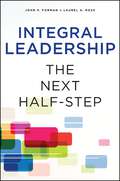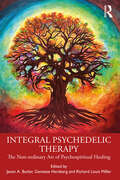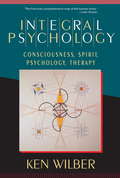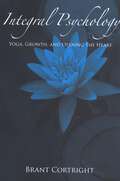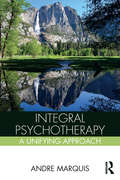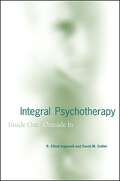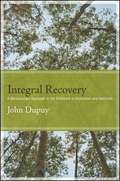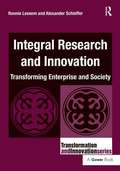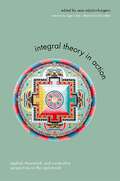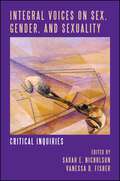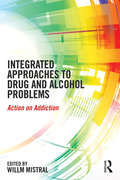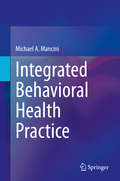- Table View
- List View
Instructional Process and Concepts in Theory and Practice: Improving the Teaching Process
by Celal AkdenizThis book offers an accessible, practical and engaging guide that provides sample instructional activities supported by theoretical background information, with a focus on the nature of the instructional process in relation to several variables. It approaches instructional models, strategies, methods, techniques, tactics and planning from a new perspective and shares effective tips to help readers better understand the instructional process and its theoretical elements. The book addresses the following questions:What is the nature of the instructional process?What are the classifications of contemporary models and strategies developed within the instructional process?Which groups yield the most effective methods and techniques, and how can they best be practically implemented?What are the instructional tactics teachers need to take into consideration, in which groups are they collected, and which tips can help us employ each tactic?Additionally, readers can adapt the book’s ready-to-use sample activities to their own educational settings. Overall, this book offers an enlightening discussion on contemporary practices related to the teaching process, a broad and holistic theoretical framework, and an ideal reference source for all students and scholars who are interested in the educational sciences.
Instructional-Design Theories and Models, Volume IV: The Learner-Centered Paradigm of Education
by Charles M. Reigeluth, Brian J. Beatty, and Rodney D. MyersInstructional-Design Theories and Models, Volume IV provides a research-based description of the current state of instructional theory for the learner-centered paradigm of education, as well as a clear indication of how different theories and models interrelate. Significant changes have occurred in learning and instructional theory since the publication of Volume III, including advances in brain-based learning, learning sciences, information technologies, internet-based communication, a concern for customizing the student experience to maximize effectiveness, and scaling instructional environments to maximize efficiency. In order to complement the themes of Volume I (commonality and complementarity among theories of instruction), Volume II (diversity of theories) and Volume III (building a common knowledge base), the theme of Volume IV is shifting the paradigm of instruction from teacher-centered to learner-centered and integrating design theories of instruction, assessment, and curriculum. Chapters in Volume IV are collected into three primary sections: a comprehensive view of the learner-centered paradigm of education and training, elaborations on parts of that view for a variety of K-12 and higher education settings, and theories that address ways to move toward the learner-centered paradigm within the teacher-centered paradigm. Instructional-Design Theories and Models, Volume IV is an essential book for anyone interested in exploring more powerful ways of fostering human learning and development and thinking creatively about ways to best meet the needs of learners in all kinds of learning contexts.
Instructional-Design Theories and Models, Volume IV: The Learner-Centered Paradigm of Education
by Charles M. Reigeluth, Brian J. Beatty, and Rodney D. MyersInstructional-Design Theories and Models, Volume IV provides a research-based description of the current state of instructional theory for the learner-centered paradigm of education, as well as a clear indication of how different theories and models interrelate. Significant changes have occurred in learning and instructional theory since the publication of Volume III, including advances in brain-based learning, learning sciences, information technologies, internet-based communication, a concern for customizing the student experience to maximize effectiveness, and scaling instructional environments to maximize efficiency.In order to complement the themes of Volume I (commonality and complementarity among theories of instruction), Volume II (diversity of theories) and Volume III (building a common knowledge base), the theme of Volume IV is shifting the paradigm of instruction from teacher-centered to learner-centered and integrating design theories of instruction, assessment, and curriculum. Chapters in Volume IV are collected into three primary sections: a comprehensive view of the learner-centered paradigm of education and training, elaborations on parts of that view for a variety of K-12 and higher education settings, and theories that address ways to move toward the learner-centered paradigm within the teacher-centered paradigm. Instructional-Design Theories and Models, Volume IV is an essential book for anyone interested in exploring more powerful ways of fostering human learning and development and thinking creatively about ways to best meet the needs of learners in all kinds of learning contexts.
Instrument Development in the Affective Domain
by D. Betsy Mccoach John P. Madura Robert K. GableWhether the concept being studied is job satisfaction, self-efficacy, or student motivation, values and attitudes--affective characteristics--provide crucial keys to how individuals think, learn, and behave. And not surprisingly, as measurement of these traits gains importance in the academic and corporate worlds, there is an ongoing need for valid, scientifically sound instruments. For those involved in creating self-report measures, the completely updated Third Edition of Instrument Development in the Affective Domain balances the art and science of instrument development and evaluation, covering both its conceptual and technical aspects. The book is written to be accessible with the minimum of statistical background, and reviews affective constructs from a measurement standpoint. Examples are drawn from academic and business settings for insights into design as well as the relevance of affective measures to educational and corporate testing. This systematic analysis of all phases of the design process includes: Measurement, scaling, and item-writing techniques.Validity issues: collecting evidence based on instrument content.Testing the internal structure of an instrument: exploratory and confirmatory factor analyses. Measurement invariance and other advanced methods for examining internal structure.Strengthening the validity argument: relationships to external variables. Addressing reliability issues. As a graduate course between covers and an invaluable professional tool, the Third Edition of Instrument Design in the Affective Domain will be hailed as a bedrock resource by researchers and students in psychology, education, and the social sciences, as well as human resource professionals in the corporate world.
Instrumental Autonomy, Political Socialization, and Citizenship Identity
by Mengyan Yolanda YuThis book offers essential insights into Chinese Korean minority youth citizenship identity development during their high school and university education period out of their political socialization experience. It investigates how they develop their citizenship identity with the state through bilingual education and media exposure, as an outcome of the entangled relationship between state power and economic globalization. The book demonstrates to readers how to apply the abstract conceptual framework of identity politics and ideology construction, nurtured by both civil culture and political evolvement, to a specific case with operationalized measurement extracted from political socialization concepts so as to understand and rationalize identity development. This approach offers both an in-depth way to penetrate further in the discourse construction that shapes identity politics and an innovative means of measuring and explaining relevant relationships.
Instrumental Social Justice in Higher Education: Eight Surveys for Workplace Bullying and Social Justice Research
by Leah P. HollisThis book offers eight validated instruments on workplace bullying to support robust mixed methods approaches for social justice research. Workplace bullying is an excellent starting point from which scholars can consider social justice research. The data shows that marginalized and disenfranchised groups (minoritized groups, women, junior faculty, and the LGBTQ+ community) are disproportionately affected. The outcomes included career interruption and severe health disparities. Though there is a demand for workplace bullying instruments, the book also lays a foundation for creating surveys to address these populations more effectively.
Instrumentation: An Introduction for Students in the Speech and Hearing Sciences
by T. Newell Decker Thomas D. CarrellWhile keeping the scope and essential thrust of the original book unchanged, this third edition has been updated to reflect the latest technology. For instance, important revisions have been made to a few chapters, while one chapter has been eliminated and replaced with a newer chapter dealing with recent developments in digital and consumer electronics that are relevant to laboratory instrumentation. The authors hope the readers of this text will be more confident with instrumentation and more willing to experiment with it, as well as be able to appreciate the possible ways that electronic instrumentation can be used in their work. The book was written with the undergraduate in speech and hearing sciences uppermost in mind. Instead of detailed information about individual pieces of instrumentation, a more basic and broad descriptive approach has been used. Throughout, examples have been provided regarding how certain pieces of equipment can be used in the clinic or laboratory. One or more step-by-step exercises are included at the end of certain chapters to help students obtain hands-on experience and equipment flowcharts help reinforce the exercise. Students who complete this book will have a basic understanding of the major pieces of instrumentation in the hearing and speech clinic/laboratory.
Insulin Resistance Syndrome and Neuropsychiatric Disease (Medical Psychiatry Series)
by Natalie L. RasgonThis is the first book of its kind to tie the metabolic syndrome with psychiatric disorders and raise the possibility that common antipsychotic treatments may have this type of adverse effect on patients. Presenting a complete overview and the relationship between insulin resistance syndrome and psychiatric and cognitive disorders, the book will be
Insurrection: To Believe Is Human To Doubt, Divine (Insurrections: Critical Studies In Religion, Politics, And Culture Ser.)
by Peter RollinsIn this incendiary new work, the controversial author and speaker Peter Rollins proclaims that the Christian faith is not primarily concerned with questions regarding life after death but with the possibility of life before death.In order to unearth this truth, Rollins prescribes a radical and wholesale critique of contemporary Christianity that he calls pyro-theology. It is only as we submit our spiritual practices, religious rituals, and dogmatic affirmations to the flames of fearless interrogation that we come into contact with the reality that Christianity is in the business of transforming our world rather than offering a way of interpreting or escaping it. Belief in the Resurrection means but one thing: Participation in an Insurrection."What Pete does in this book is take you to the edge of a cliff where you can see how high you are and how far you would fall if you lost your footing. And just when most writers would kindly pull you back from edge, he pushes you off, and you find yourself without any solid footing, disoriented, and in a bit of a panic…until you realize that your fall is in fact, a form of flying. And it's thrilling."--Rob Bell, author of Love Wins and Velvet Elvis"While others labor to save the Church as they know it, Peter Rollins takes an ax to the roots of the tree. Those who have enjoyed its shade will want to stop him, but his strokes are so clean and true that his motive soon becomes clear: this man trusts the way of death and resurrection so much that he has become fearless of religion." --Barbara Brown Taylor, author of Leaving Church and An Altar in the World“Rollins writes and thinks like a new Bonhoeffer, crucifying the trappings of religion in order to lay bare a radical, religionless and insurrectional Christianity. A brilliant new voice—an activist, a storyteller and a theologian all in one—and not a moment too soon.” --John D. Caputo, Thomas J. Watson Professor of Religion Emeritus, Syracuse University“What does it mean when the Son of God cries out, ‘My God, My God, why have you forsaken me’? Brilliantly, candidly, and faithfully, Rollins wrestles here with that question. You may not agree with his answers and conclusions, but you owe it to yourself and to the Church at large to read what he says.” --Phyllis Tickle, author, The Great Emergence"Excellent thinking and excellent writing! I hope this fine book receives the broad reading it deserves. It will change lives, and our understanding of what religion is all about!"-- Rohr,O.F.M., Center for Action and Contemplation; Albuquerque, New Mexico
Intangiball: The Subtle Things That Win Baseball Games
by Lonnie WheelerA unique and refreshing ode to the “little things” that represent baseball’s heartbeat—the player who, in countless ways, makes other players better.Intangiball tracks the progress of the Cincinnati Reds through five years of culture change, beginning with the trades of decorated veterans Adam Dunn and Ken Griffey, Jr. It also draws liberally from such character-conscious clubs as the Atlanta Braves, St. Louis Cardinals, San Francisco Giants, New York Yankees, and Tampa Bay Rays. Author, sportswriter, and eternal fan of the game, Lonnie Wheeler systematically identifies the performance-enhancing qualities (PEQs) that together comprise the “communicable competitiveness” that he calls “teamship.” Intangiball is not designed to debunk Moneyball, but rather to sketch in what it left out: “What order is there to a baseball world in which a struggling rookie benefits not a bit from the encouraging words of the veteran who drapes his arm around the kid’s shoulders; in which Derek Jeter’s professionalism serves none but him; in which there is no reward for hustle, no edge for enthusiasm, no payoff for sacrifice; in which there is no place for the ambient contributions of David Eckstein, Marco Scutaro, or the aging, battered Scott Rolen; in which shared purpose serves no purpose?” Intangibles, as it turns out, not only ennoble the game; they help win it. And this is the book every fan must read.
Intangibles: Unlocking the Science and Soul of Team Chemistry
by Joan RyanFrom baseball to biology, an award-winning journalist highlights the power of team chemistry in this "terrific" data-driven investigation of human relationships (Billie Jean King).Does team chemistry actually exist? Is there scientific or mathematical proof? Is team chemistry as real and relevant as on-base percentages and wins above replacement?In Joan Ryan's groundbreaking book we discover that the answer to all of the above is a resounding yes. As Ryan puts it, team chemistry, or the combination of biological and social forces that boosts selfless effort among more players over more days of a season, is what drives sports teams toward a common goal, encouraging the players to be the best versions of themselves. These are the elements of teams that make them "click," the ones that foster trust and respect, and push players to exceed their own potential when they work well together.Team chemistry alone won't win a World Series, but talent alone won't win it, either. And by interviewing more than 100 players, coaches, managers, and statisticians, as well as over five years of extensive research in neuroscience, biology, physiology, and psychology, Ryan proves that the social and emotional state of a team does affect performance. Grit, passion, selflessness, and effort matter -- but never underestimate the power of chemistry.
Integral Conflict: The New Science of Conflict (SUNY series in Integral Theory)
by Richard J. McGuigan Nancy PoppThis book explores conflict through the discerning lens of Integral Theory, applying Ken Wilber's AQAL model to a real-life case study, the River Conflict. Coauthor Richard J. McGuigan was a mediator in this ongoing dispute over fishing rights on the Fraser River in British Columbia, a situation where commercial, recreational, and First Nations fishing interests clashed. Voices of the various stakeholders are featured prominently, giving a vivid sense of a seemingly intractable situation. McGuigan and Nancy Popp set the stage for their Integral analysis of the River Conflict, then move expertly through four chapters aimed at understanding the conflict from the four dimensions of human experience: individual, collective, interior, and exterior. The result is a powerful picture of just how "integral" conflict is. This quadrant-by-quadrant analysis is well-punctuated by sidebar observations, insights, and tips for conflict practitioners or students, giving readers new to Integral Theory additional support in understanding and applying the AQAL model to their work.
Integral Dreaming: A Holistic Approach to Dreams (SUNY series in Dream Studies)
by Daniel Deslauriers Fariba BogzaranThis innovative book offers a holistic approach to one of the most fascinating and puzzling aspects of human experience: dreaming. Advocating the broad-ranging vision termed "integral" by thinkers from Aurobindo to Wilber, Fariba Bogzaran and Daniel Deslauriers consider dreams as multifaceted phenomena in an exploration that includes scientific, phenomenological, sociocultural, and subjective knowledge. Drawing from historical, cross-cultural, and contemporary practices, both interpretive and noninterpretive, the authors present Integral Dream Practice, an approach that emphasizes the dreamer's creative participation, reflective capacities, and mindful awareness in working with dreams. Bogzaran and Deslauriers have developed this comprehensive way of approaching dreams over many years and highlight their methods in a chapter that unfolds a single dream, showing how sustained creative exploration over time leads to transformative change.
Integral Leadership: The Next Half-Step (Excelsior Editions)
by John P. Forman Laurel A. RossThis groundbreaking book offers leaders a way to determine what theories, models, and tools best meet the needs of their organizations. Authors and organizational consultants John P. Forman and Laurel A. Ross know leaders are awash in business theory, often coming from well-thumbed bestsellers. But how do you match promising theories to real people and circumstances? Using the insights of Integral Theory, particularly Ken Wilber's AQAL framework, the authors provide a simple yet elegant outline that appreciates and engages a wide range of leadership theories and techniques. Four major leadership styles emerge: the Impulsive, Diplomatic, Achiever, and Pluralistic approaches. The authors describe the presuppositions, characteristics, advantages, and disadvantages of each using a variety of real-life examples of individual leaders and organizations. Forman and Ross propose an emerging Integral perspective and suggest integral modes of performance management, change management, and teamwork. Ultimately, the Integral perspective gives leaders the insight and flexibility to use a range of resources to meet organizational needs in a rapidly changing world.
Integral Psychedelic Therapy: The Non-ordinary Art of Psycho-spiritual Healing
by Jason A. Butler Genesee Herzberg Richard Louis MillerIntegral Psychedelic Therapy is a groundbreaking, evidence-based collection that explores how psychedelic medicine can be incorporated into contemporary psychotherapy. This book builds on current psychedelic research by providing an in-depth articulation of the practice of psychedelic therapy, weaving together a variety of complementary therapeutic frameworks, case examples, and practical guidance for cultivating a highly effective, ethically grounded, integral approach. Chapters by a diverse set of practicing psychotherapists and leading researchers aim to provide practitioners with a method that centers liberation of all dimensions of being through intersectional, client-centered, trauma-informed, and attachment-focused practices, alongside thoughtful attunement to the relational, somatic, imaginal, cultural, and transpersonal dimensions of healing. Integral Psychedelic Therapy will be essential reading for psychotherapists in practice and in training as well as those seeking personal healing and holistic transformation.
Integral Psychology
by Ken WilberThe goal of an "integral psychology" is to honor and embrace every legitimate aspect of human consciousness under one roof. This book presents one of the first truly integrative models of consciousness, psychology, and therapy. Drawing on hundreds of sources--Eastern and Western, ancient and modern--Wilber creates a psychological model that includes waves of development, streams of development, states of consciousness, and the self, and follows the course of each from subconscious to self-conscious to superconscious. Included in the book are charts correlating over a hundred psychological and spiritual schools from around the world, including Kabbalah, Vedanta, Plotinus, Teresa of Ávila, Aurobindo, Theosophy, and modern theorists such as Jean Piaget, Erik Erikson, Jane Loevinger, Lawrence Kohlberg, Carol Gilligan, Erich Neumann, and Jean Gebser. Integral Psychology is Wilber's most ambitious psychological system to date and is already being called a landmark study in human development.
Integral Psychology: Yoga, Growth, and Opening the Heart (SUNY series in Transpersonal and Humanistic Psychology)
by Brant CortrightIntegral Psychology connects Eastern and Western approaches to psychology and healing. Psychology in the East has focused on our inner being and spiritual foundation of the psyche. Psychology in the West has focused on our outer being and the wounding of the body-heart-mind and self. Each requires the other to complete it, and in bringing them together an integral view of psychology comes into view.The classical Indian yogas are used as a way to see psychotherapy: psychotherapy as behavior change or karma yoga; psychotherapy as mindfulness practice or jnana yoga; psychotherapy as opening the heart or bhakti yoga. Finally, an integral approach is suggested that synthesizes traditional Western and Eastern practices for healing, growth, and transformation.
Integral Psychotherapy: A Unifying Approach
by Andre MarquisIntegral Psychotherapy lays out a conceptual framework for understanding and applying the wide range of psychotherapeutic approaches. The unifying model presented here addresses the dynamics of healthy human development, the assessment process, techniques and processes of therapeutic change, and much, much more. Beginning as well as experienced mental health practitioners will find the integral approach to be an exquisitely parsimonious model, one that allows practitioners and researchers to retain their own style and preferences, while simultaneously organizing ideas within a more comprehensive framework for understanding human beings and the psychotherapeutic process.
Integral Psychotherapy: Inside Out/Outside In (SUNY series in Integral Theory)
by R. Elliott Ingersoll David M. ZeitlerIn Integral Psychotherapy, self-help meets rigorous scholarship. Integral Psychotherapy is a dynamic framework for understanding the mind and uniting spirituality and psychotherapy. Authors Elliott Ingersoll and David M. Zeitler use Ken Wilber's Integral Model to guide readers through a startling new view of psychotherapy as a spiritual journey of self-discovery. This is the first book that grounds the Integral approach in mainstream research while showing how Integral Psychotherapy treats body, mind, and spirit, and it offers an accurate history of many psychological ideas (some mistaken) prevalent in our society. Integral Psychotherapy debunks the fads and fashions of self-help gurus while mapping terrain readers can use to bring their lives into focus. With humor and compassion the authors show that the life of the mind is complex and complexity is our friend.
Integral Recovery: A Revolutionary Approach to the Treatment of Alcoholism and Addiction
by John DupuyThis book is for everyone who is suffering from the disease of addiction or who cares about someone who is: for addicts, their families and friends, and their health care providers. It is for those who are currently in recovery and looking for a way to shift their recovery into a higher gear--from just surviving and muddling through to becoming the absolute best version of themselves, from mere recovery to Integral Recovery.
Integral Research and Innovation: Transforming Enterprise and Society
by Ronnie Lessem Alexander SchiefferAt a time when business practitioners and others responsible for organizational development are desperate for usable knowledge the authors of this book contend that social science research is failing to support business and management. In Integral Research and Innovation, they explain how research has to be transformative, rather than just informative if it is to contribute usefully to building integrated and sustainable enterprises. Drawing on their experience of environments where researchers and practitioners do engage constructively, resulting in research that is active, participative, and genuinely innovative, Professor Lessem and Dr Schieffer are in territory that is far beyond that covered by standard works on research methodology.
Integral Theory in Action: Applied, Theoretical, and Constructive Perspectives on the AQAL Model (SUNY series in Integral Theory)
by Ken WilberIn a world as complex as ours, an integral approach is needed to help sort through a dynamic landscape and respond effectively to individual and collective challenges. Integral Theory in Action provides the first multi-authored overview of such an approach. Integral Theory is the result of 30 years of research and is being applied in over 35 distinct disciplines. This volume brings together two dozen leading scholar-practitioners who are actively applying integral principles and who address a range of issues from an integral perspective including: climate change, embodiment, feminist aesthetics, community discourse, treatment of depression, developmental theory, and global ethics. The strengths, limitations, and potential of Integral Theory and Ken Wilber's AQAL model are weighed by each contributor. This collection pushes the field of Integral Theory in new ways and new directions, and provides a comprehensive overview that makes it an invaluable resource for any integral effort.
Integral Voices on Sex, Gender, and Sexuality: Critical Inquiries (SUNY series in Integral Theory)
by Sarah E. Nicholson; Vanessa D. FisherThis volume takes a unique approach to the question of what it is to be a gendered, sexual self in a postmodern world, offering insights informed by the Integral paradigm of theory and practice. With the inquiry into sex, gender, and sexuality having become so broad and diverse within both academia and popular culture, the Integral approach can help sift through and make sense of the cacophony of theories and agendas that seek to stake their ground in this collective conversation. Informed by the work of thinkers such as Sri Aurobindo, Gregory Bateson, Jean Gebser, Ervin Laszlo, and, most directly, Ken Wilber, the Integral approach acknowledges and works with multiple and contradictory experiences, theories, and realities. Dealing with a variety of topics, including feminism, the men's movement, sexual identity, queer history, and spirituality, the work's contributors speak from across the spectrum of personal and political backgrounds, academic and practitioner orientations, and male and female perspectives. The combination of voices aims to bring forward a more complex and integrated understanding of what it means to be woman, man, human.
Integrated Approaches to Drug and Alcohol Problems: Action on addiction
by Willm MistralIntegrated Approaches to Drug and Alcohol Problems: Action on Addiction provides a pathway through the field of addiction, giving a clear description of points along that path, from the beginning of problematic use of drugs and alcohol, to treatment, support, recovery and reintegration in society. The book illustrates the principle of integrated approaches to tackling the rise in problems with addiction. Practical applications of these approaches are demonstrated in the work of UK charity Action on Addiction, one organisation which has been influenced by, and contributed to, the research and practice of the authors. The interventions illustrated within Integrated Approaches to Drug and Alcohol Problems demonstrate how the findings of international research can be brought together to provide effective services for individuals, families and communities suffering from addiction-related problems.Some of the foremost internationally recognized addiction researchers, clinicians and trainers from the UK, USA and Canada have contributed chapters to this book. It will be of interest to all those working in the field of drug and alcohol addiction, including counsellors and therapists, as well as GPs, nurses and public health officers. Integrated Approaches to Drug and Alcohol Problems will also have general appeal to anyone studying Psychology and Mental Health courses at undergraduate or postgraduate level, plus those affected by addiction.
Integrated Behavioral Health Practice
by Michael A. ManciniThis valuable resource prepares graduate-level students in social work and other helping professions to provide integrated behavioral health services in community-based health and mental healthcare settings. Responding to the increasing prevalence of behavioral health issues in the general U.S. population and the resulting additional responsibilities for social workers and health professionals, this textbook describes the latest evidence-based practices and interventions for common behavioral health disorders as well as issues related to suicide, violence, substance use, and trauma. Detailed case studies help illustrate the effects of a range of interventions, inviting readers to consider how best to implement behavioral health assessment and treatment practices that are evidence-based, trauma-informed, and recovery-oriented. In addition to outlining integrated behavioral health service models and assessment tools, chapters address specific topics such as: Public health approaches to addressing interpersonal violenceIntersections of social, behavioral, and physical healthAchieving recovery and well-being from behavioral health disordersMotivating clients to achieve and maintain recovery from addictionStage-based treatments for substance use disordersCognitive behavioral approaches to treating anxiety and depressive disordersEvidence-based approaches to treating the effects of trauma and PTSD Integrated Behavioral Health Practice equips graduate students and health professionals alike to provide sensitive and informed interprofessional care for patients and families while consistently engaging in practices that emphasize recovery and well-being.
